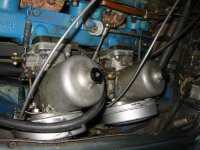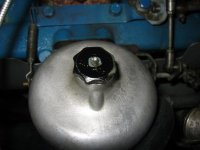[ QUOTE ]
Dave - Are you saying that I the carbs can function without the dampers in?
Thanks,
-Brandon
[/ QUOTE ]
Yes, the carbs could function without the dampers although not too well. It would be about the same as having no oil in them.
The SU carbs have no accelerator pump. When the throttle butterflies are suddenly opened, the dampers retard the piston's opening which serves to temporarily richen the mixture until the pistons reach their proper flow balance point. This takes the place of the accelerator pumps in other carburetors. The amount of throttle opening enrichment is controlled by the damper oil viscosity. Heavy oil is equivalent to more accelerator pump flow.
The dampers must be very mechanically straight & centered so that they present no mechanical drag to the piston movement. A temporary repair of a broken cap "could" work if the damper piston/shaft fits perfectly straight & concentric with the piston's oil chamber bore.
As others have said, With oil in the dampers, raising the piston in the carb intake with your finger should present moderate, smooth resistance when raising the piston & it should drop back down quickly with an audible click as it hits bottom. If the pistons move freely in both directions on this test with the dampers removed but not with dampers installed, & with no oil in them, the dampers are binding or bent.
Another source of piston binding can be that the lower jet is not centered. There is a procedure for jet centering.
To go a step further, a piston placed in it's inverted housing without the spring, should spin smoothly throughout it's range of up/down travel without contacting the sides of the housing. Sometimes tiny dents in the housing can cause contact. This can be corrected by carefully polishing off the high spots (dents) in the housing. As I said earlier, the piston & housing assemblies are carefully matched. If they get interchanged the fit can be too tight. Switching the parts can correct the lack of clearance.
To check actual piston to housing clearance for correct, there is a piston drop timing test that is listed in the manuals.
If everything was correct before the "misshap" a new damper/cap should correct the problem. It wouldn't hurt to check the rest of these items to assure that you have the best possible operation.
D

 Hi Guest!
Hi Guest!

 smilie in place of the real @
smilie in place of the real @
 Pretty Please - add it to our Events forum(s) and add to the calendar! >>
Pretty Please - add it to our Events forum(s) and add to the calendar! >> 


